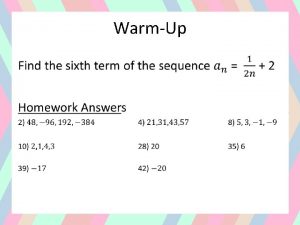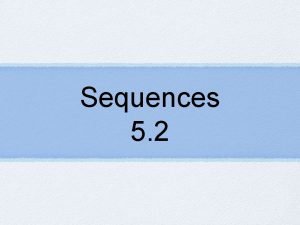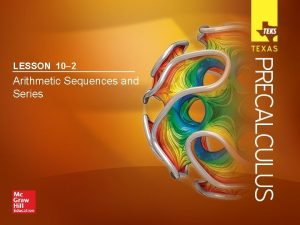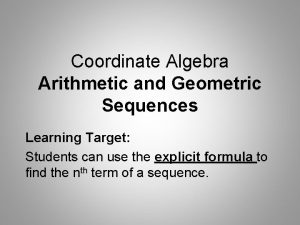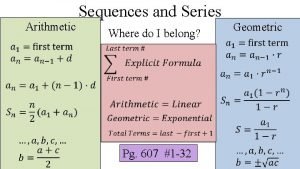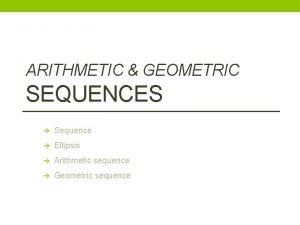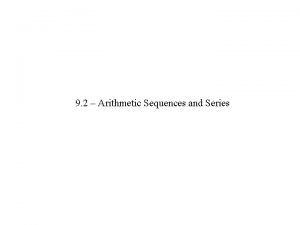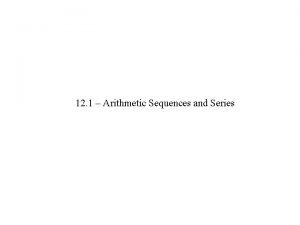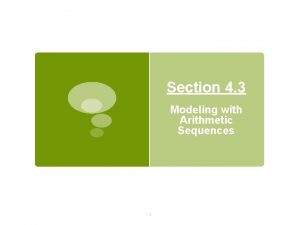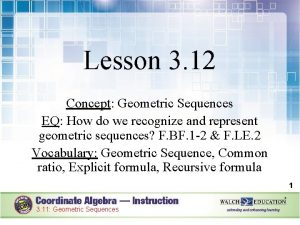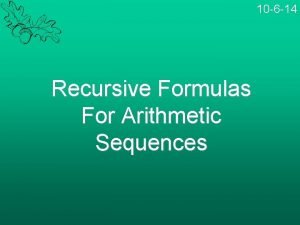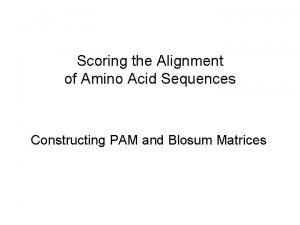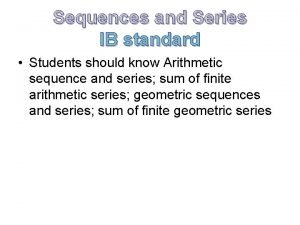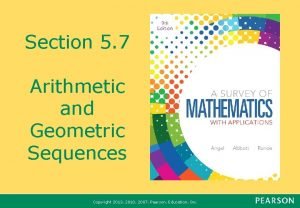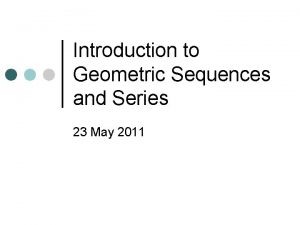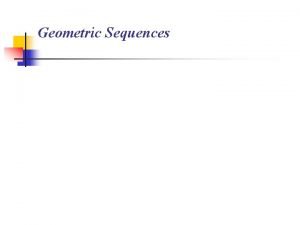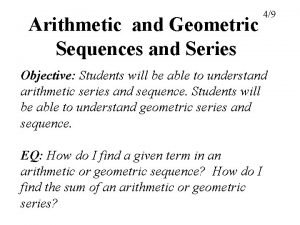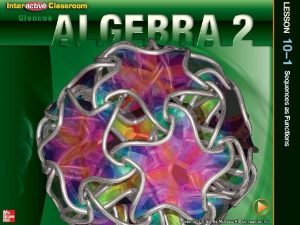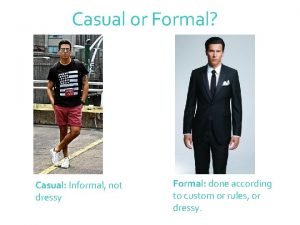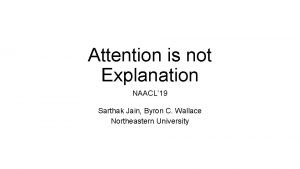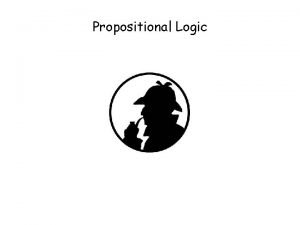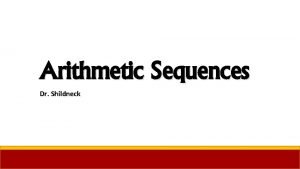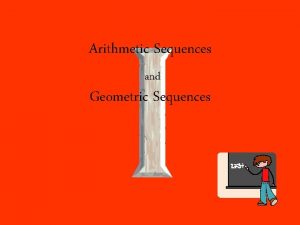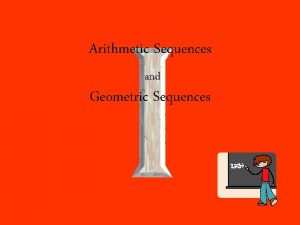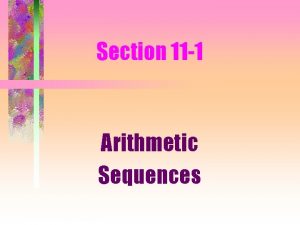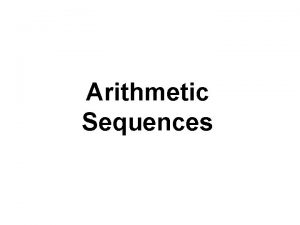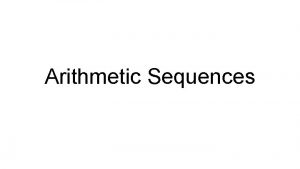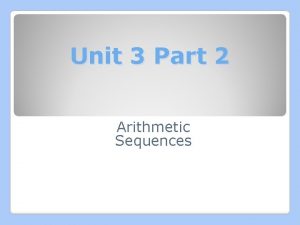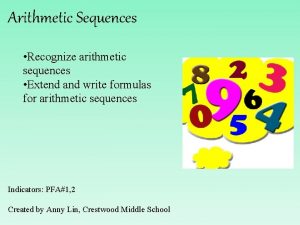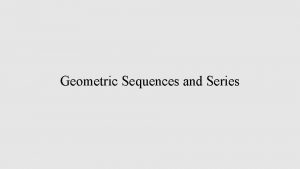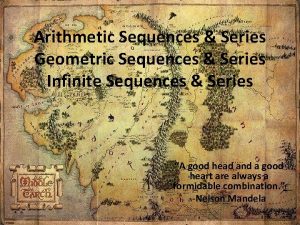More on Sequences Some sequences are not arithmetic



















































- Slides: 51

More on Sequences Some sequences are not arithmetic and therefore begin with a 1 st position. Some sequences come from patterns that occur in nature, and some from patterns of figures.

These are the triangular figures and give rise to triangular numbers.

1, 3, 6, 10, 15, …

1, 3, 6, 10, What is the pattern? 15, …

1, 3, 6, 10, What is the pattern? Look at the first differences. 15, …

1, 2, 3, 6, 4, 10, 5, … 15, … The first differences are not all the same, but the set of first differences should look familiar. Find the second differences.

1, 2, 3, 1, 3, 6, 1, 4, 10, 5, … 1, … The second differences are all the same; therefore, the first differences are arithmetic.

1, 2, 3, 6, 4, 10, 5, … Notice the following relationships: 1=1 15, …

1, 2, 3, 6, 4, 10, 5, … Notice the following relationships: 1=1 3=1+2 15, …

1, 2, 3, 6, 4, 10, 5, … Notice the following relationships: 1=1 3=1+2 6=1+2+3 15, …

1, 2, 3, 6, 4, 10, 5, … Notice the following relationships: 1=1 3=1+2 6=1+2+3 10 = 1 + 2 + 3 + 4 15, …

1, 2, 3, 6, 4, 10, 5, … 15, … Notice the following relationships: 1=1 3=1+2 6=1+2+3 10 = 1 + 2 + 3 + 4 A triangular number is nothing more that the sum of an arithmetic sequence.

1, 2, 3, 6, 4, 10, 5, … 15, … Recall that the sequence is not arithmetic and therefore begins with position 1.

1, 3, 6, 10, 15, … 1 st 2 nd 3 rd 4 th 5 th These are the position numbers.

1, 2, 3, 6, 4, 10, 5, … The 1 st triangular number is 1. The 2 nd triangular number is 1 + 2. The 3 rd triangular number is 1 + 2 + 3, etc… 15, …

1, 2, 3, 6, 4, 10, What is the 17 th triangular number? 5, … 15, …

1, 2, 3, 6, 4, 10, What is the 17 th triangular number? T 17 = 1 + 2 + 3 + … + 15 + 16 + 17 5, … 15, …

1, 2, 3, 6, 4, 10, 5, … What is the 17 th triangular number? T 17 = 1 + 2 + 3 + … + 15 + 16 + 17 T 17 = 17 + 16 + 15 + …+ 3 + 2 + 1 15, …

1, 2, 3, 6, 4, 10, 5, … What is the 17 th triangular number? T 17 = 1 + 2 + 3 + … + 15 + 16 + 17 T 17 = 17 + 16 + 15 + …+ 3 + 2 + 1 2 T 17 = 18 + …+18 + 18 15, …

1, 2, 3, 6, 4, 10, 5, … What is the 17 th triangular number? T 17 = 1 + 2 + 3 + … + 15 + 16 + 17 T 17 = 17 + 16 + 15 + …+ 3 + 2 + 1 2 T 17 = 18 + …+18 + 18 2 T 17 = 18(17) 15, …

1, 2, 3, 6, 4, 10, 5, … What is the 17 th triangular number? T 17 = 1 + 2 + 3 + … + 15 + 16 + 17 T 17 = 17 + 16 + 15 + …+ 3 + 2 + 1 2 T 17 = 18 + …+18 + 18 2 T 17 = 18(17) T 17 = 153 15, …

1, 2, 3, 6, 4, 10, 5, … 15, … A more general question is what does a general triangular number look like.

We must be able to describe any number we want in an arithmetic sequence. If an arithmetic sequence has a step size of 4 and an initial step of 5, then the number in the 12 th position (the 13 th term in the sequence) will be 4(12) + 5

We must be able to describe any number we want in an arithmetic sequence. If an arithmetic sequence has a step size of 4 and an initial step of 5, then the number in the 12 th position (the 13 th term in the sequence) will be 4(12) + 5 If an arithmetic sequence has a step size of 4 and an initial step of 5, then the number in the 23 rd position (the 24 th term in the sequence) will be 4(23) + 5

We must be able to describe any number we want in an arithmetic sequence. What would be the nth term in the sequence? 4 n + 5 This means there are n + 1 terms in the entire sequence to this point. What would be the term just before the nth term? 4(n – 1) + 5 = 4 n + 1

1, 2, 3, 6, 4, 10, 5, … 15, … A more general question is what does a general triangular number look like. In order to answer this question we must first find the general term of the sequence of first differences.

1, 2, 3, 6, 4, 10, 5, … 15, … Since the first differences are 1 and the initial step is 1*, then the general nth term is 1(n-1) + 1 or n. We begin at 1 since the sums we want begin with a one, i. e. , 10 = 1 + 2 + 3 + 4

1, 2, 3, 6, 10, 4, 5, … Now let us answer the question what is 1+2+3+…+ + Let us fill in the blanks. + ( n ). 15, …

1, 2, 3, 6, 4, 10, 5, … Now let us answer the question what is 1 + 2 + 3 + … + (n-2) + (n-1) + ( n ). How to answer the above question. 15, …




1, 2, 3, 6, 4, 10, 5, … 15, … What does this formula do you ask. Watch this! S = n(n 2+ 1) n =1 S = 1(1 + 1)/ 2 = 2/2 = 1

1, 2, 3, 6, 4, 10, 5, … 15, … What does this formula do you ask. Watch this! S = n(n 2+ 1) n =1 S = 1(1 + 1)/ 2 = 2/2 = 1 n=2 S = 2(2 + 1)/2 = 2(3)/2 = 3

1, 2, 3, 6, 4, 10, 5, … 15, … What does this formula do you ask. Watch this! S = n(n 2+ 1) n =1 S = 1(1 + 1)/ 2 = 2/2 = 1 n=2 S = 2(2 + 1)/2 = 2(3)/2 = 3 n=3 S = 3(3 + 1)/2 = 3(4)/2 = 6

1, 2, 3, 6, 4, 10, 5, … 15, … What does this formula do you ask. Watch this! S = n(n 2+ 1) n =1 S = 1(1 + 1)/ 2 = 2/2 = 1 n=2 S = 2(2 + 1)/2 = 2(3)/2 = 3 n=3 S = 3(3 + 1)/2 = 3(4)/2 = 6 n=4 S = 4(4 + 1)/2 = 4(5)/2 = 10

1, 2, 3, 6, 4, 10, 5, … 15, … This formula generates triangular numbers starting with a 1 st position. S = n(n 2+ 1)

1, 3, 4, 2, 5, 9, 16, …. (square numbers) 7, …. . (first differences) 2, …. . (second differences)

1, 3, 4, 5, 9, 16, …. (square numbers) 7, …. . (first differences) Notice that 1 =1 1 st square number (0 th term sum) 4 =1+3 2 nd square number (1 st term sum) 9 =1+3+5 3 rd square number (2 nd term sum) 10 16 = 1 + 3 + 5 + 7, etc….

1, 3, 4, 5, 9, 16, …. (square numbers) 7, …. . (first differences) To solve the problem look at the set of first differences, and find a sum of the first n terms. In order to do this we must first describe the term in the nth position of the sequence of first differences.

1, 3, 4, 5, 9, 16, …. (square numbers) 7, …. . (first differences) To solve the problem look at the set of first differences, and find a sum of the first n terms. In order to do this we must first describe the term in the nth position of the sequence of first differences. 2 n + 1

1, 3, 4, 5, 9, 16, …. (square numbers) 7, …. . (first differences) To solve the problem look at the set of first differences, and find a sum of the first n terms or the term in position n - 1. Because arithmetic sequences from a 0 th position 2(n – 1) + 1 = 2 n – 2 + 1 = 2 n - 1

1, 3, 4, 5, 9, 16, …. (square numbers) 7, …. . (first differences) So any square number is described by the sum: S=1 + 3 + … +(2 n – 5) + (2 n – 3) + (2 n – 1)

1, 3, 4, 5, 9, 16, …. (square numbers) 7, …. . (first differences) How to sum such a sequence, Gauss’s trick S= 1 + 3 +… + (2 n – 3) + (2 n – 1) S = (2 n – 1) + (2 n – 3) + … + 3 + 1

1, 3, 4, 5, 9, 16, …. (square numbers) 7, …. . (first differences) How to sum such a sequence, Gauss’s trick S= 1 + 3 +… + (2 n – 3) + (2 n – 1) S = (2 n – 1) + (2 n – 3) + … + 3 2 S = (2 n) + …. + (2 n) 2 S = (2 n)(n) 2 S = 2 n 2 S = n 2 + 1 + (2 n)

1, 5, 12, Are the pentagonal numbers. What is the pattern? 22, …

1, First differences: 4 , Second differences: 5, 12, 7, 3, 10, … 3, …. . 22, …

1, 5, First differences: 4 , 12, 7, Notice that 1=1 5=1+4 12 = 1 + 4 + 7, etc… 22, … 10, …

1, 5, First differences: 4 , 12, 7, 22, … 10, … General term for the first differences is 3 n + 1. If we want to add n numbers of this form add from the 0 th to the (n – 1)th terms.


 Lirik lagu more more more we praise you
Lirik lagu more more more we praise you More more more i want more more more more we praise you
More more more i want more more more more we praise you Mikael ferm
Mikael ferm Aspire not to
Aspire not to Unit 10 sequences and series homework 1 answers
Unit 10 sequences and series homework 1 answers Write variable expressions for arithmetic sequences
Write variable expressions for arithmetic sequences 10-2 arithmetic sequences and series
10-2 arithmetic sequences and series Explicit formula
Explicit formula Arithmetic series formula
Arithmetic series formula Arithetic sequence
Arithetic sequence Geometric sequence
Geometric sequence Geometric sequences formula
Geometric sequences formula 9-2 arithmetic sequences
9-2 arithmetic sequences 5/9
5/9 Modeling with arithmetic sequences
Modeling with arithmetic sequences Lesson 3: arithmetic and geometric sequences
Lesson 3: arithmetic and geometric sequences Recursive formula for arithmetic sequence
Recursive formula for arithmetic sequence Constructing arithmetic sequences
Constructing arithmetic sequences Write a rule for the sequence 5 -4 -13 -22
Write a rule for the sequence 5 -4 -13 -22 Sequences and series formulas
Sequences and series formulas Geometric equation
Geometric equation Un=u1rn-1
Un=u1rn-1 Geometric sequences formula
Geometric sequences formula Arithmetic and geometric sequences and series
Arithmetic and geometric sequences and series Sadlier level d unit 1 synonyms
Sadlier level d unit 1 synonyms Determine whether the sequence is arithmetic or not
Determine whether the sequence is arithmetic or not They say it only takes a little faith to move a mountain
They say it only takes a little faith to move a mountain They say it only takes a little faith to move a mountain
They say it only takes a little faith to move a mountain An ice cream countable or uncountable
An ice cream countable or uncountable Contact and non contact forces
Contact and non contact forces Fire and ice diamante poem
Fire and ice diamante poem Some say the world will end in fire some say in ice
Some say the world will end in fire some say in ice Some trust in horses
Some trust in horses The ______ of a seismograph moves.
The ______ of a seismograph moves. Gurpreet sangha accident
Gurpreet sangha accident The more you take the more you leave behind
The more you take the more you leave behind The more you study the more you learn
The more you study the more you learn Example of first law of motion
Example of first law of motion Knowing more remembering more
Knowing more remembering more The more i give to thee the more i have
The more i give to thee the more i have More choices more chances
More choices more chances Human history becomes more and more a race
Human history becomes more and more a race Key issue 4 why are some human actions not sustainable
Key issue 4 why are some human actions not sustainable Key issue 4 why are some actions not sustainable
Key issue 4 why are some actions not sustainable Some things are caught not taught
Some things are caught not taught Composed upon westminster bridge figures of speech
Composed upon westminster bridge figures of speech There is no woman's sides
There is no woman's sides If you're not confused you're not paying attention
If you're not confused you're not paying attention Informal-casual
Informal-casual Attention is not not explanation
Attention is not not explanation Not too broad and not too narrow
Not too broad and not too narrow P then q
P then q




